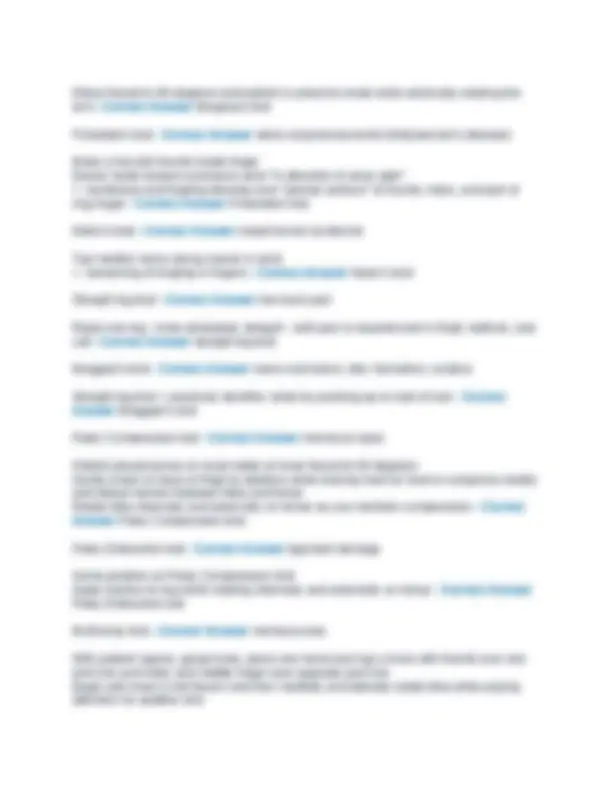












Study with the several resources on Docsity

Earn points by helping other students or get them with a premium plan


Prepare for your exams
Study with the several resources on Docsity

Earn points to download
Earn points by helping other students or get them with a premium plan
Community
Ask the community for help and clear up your study doubts
Discover the best universities in your country according to Docsity users
Free resources
Download our free guides on studying techniques, anxiety management strategies, and thesis advice from Docsity tutors
A detailed overview of various aspects of the immune system and common gastrointestinal disorders. It covers topics such as the role of b-lymphocytes and t-lymphocytes in the immune response, the different types of immunoglobulins (igm, igg, iga, ige, and igd) and their functions, the four types of hypersensitivity reactions, and the chemical mediators involved in the inflammatory process. The document also delves into the characteristics, symptoms, and complications of various gastrointestinal conditions, including duodenal and gastric ulcers, appendicitis, irritable bowel syndrome (ibs), crohn's disease, ulcerative colitis, and diverticulitis. Additionally, it covers the specific quadrants of the abdomen affected by these disorders. This comprehensive resource can be valuable for students and professionals in the fields of medicine, biology, and healthcare.
Typology: Exams
1 / 18

This page cannot be seen from the preview
Don't miss anything!











Beriberi Loss of appetite Fatigue - Correct Answer vitamin B1 (thiamin) Mouth sores Angular chelates Dry mouth - Correct Answer vitamin B2 (riboflavin) Adrenal problems Nerve damage - Correct Answer vitamin B5 (pantothenic acid) Anemia & seizures Slow growth Skin problems - Correct Answer vitamin B6 (pyrimidine) Anemia - Correct Answer vitamin B9 (folic acid) Severe alcoholics often lack these two B vitamins - Correct Answer B9, B Vegetarians may lack this B vitamin - Correct Answer B Hemolytic anemia (children) - Correct Answer vitamin E (tocopherols) Skin problems Loss of hair - Correct Answer vitamin H (biotin) Poor immunity Poor concentration Anemia Fatigue Itching Pica - Correct Answer iron Easy tooth decay - Correct Answer fluoride Simple goiter
Cretinism - Correct Answer iodine Immune function Wound healing Diarrhea Eye diseases Common cold - Correct Answer zinc Coenzymes that facilitate reactions in Krebs cycle? - Correct Answer B vitamins, vitamin H (biotin) Acid-suppressing drugs & antacids Digoxin HRT (estrogens) Oral contraceptives Oral hypoglycemic - Correct Answer B complex Antipsychotics - Correct Answer vitamin B2, vitamin C Antibiotics Antidepressants Diuretics HRT (estrogens) Oral contraceptives - Correct Answer vitamin B Antiepileptics Antibiotics - Correct Answer vitamin B Acid-suppressing drugs & antacids Antibiotics Antiepileptics Corticosteroids Anticonvulsants - Correct Answer vitamin D Acid-suppressing drugs & antacids Antihypertensive - Correct Answer iron Acid-suppressing drugs & antacids ACE inhibitors Diuretics - Correct Answer zinc Upper border of liver - Correct Answer 5th or 6th ICS Lower border of liver (laterally) - Correct Answer 10th or 11th rib Lower border of liver (medially) - Correct Answer xiphoid process
VERTICAL ANATOMICAL LEVELS: beginning of esophagus and trachea - Correct Answer C VERTICAL ANATOMICAL LEVELS: highest point of thoracic duct (lymph drainage) - Correct Answer C VERTICAL ANATOMICAL LEVELS: apex of lungs - Correct Answer T VERTICAL ANATOMICAL LEVELS: arch of aorta - Correct Answer T VERTICAL ANATOMICAL LEVELS: inferior angle of scapula - Correct Answer T VERTICAL ANATOMICAL LEVELS: xiphoid -- sternal angle - Correct Answer T VERTICAL ANATOMICAL LEVELS: esophageal hiatus in diaphragm - Correct Answer T VERTICAL ANATOMICAL LEVELS: end of spinal cord, testicular or ovarian artery - Correct Answer L VERTICAL ANATOMICAL LEVELS: inferior mesenteric artery - Correct Answer L VERTICAL ANATOMICAL LEVELS: iliac crest, umbilicus - Correct Answer L Conduct impulses -- the "wiring" of the nervous system's information circuits - Correct Answer neurons Contains nucleus, cytoplasm, and organelles - Correct Answer soma (cell body) Branches from the cell bodies Receive stimuli that initiate nerve signals - Correct Answer dendrites Conducts impulses away from cell body - Correct Answer axon Peptide and transmitter of many central neurons (dorsal root ganglia and basal ganglia) Transmits pain - Correct Answer Substance P Act like opiates to block pain - Correct Answer endorphins, encephalin Alzheimer's disease treatment a) Cholinergic enhancers (Aricept - donepezil), tricyclic antidepressants (Remer on - mirtazapine), Provigil, NSAIDs, meantime, gingko biloba b) Levodopa, anticholinergics c) Interferon, corticosteroids, plasmapheresis, lioresal - baclofen, tizanidine - zanaflex, benzodiazepines, antidepressants, amantadine
d) Carbamazepine, phenytoin, amitriptyline e) Corticosteroids - Correct Answer A Parkinson's disease treatment a) Cholinergic enhancers (Aricept - donepezil), tricyclic antidepressants (Remer on - mirtazapine), Provigil, NSAIDs, meantime, gingko biloba b) Levodopa, anticholinergics c) Interferon, corticosteroids, plasmapheresis, lioresal - baclofen, tizanidine - Zana flex, benzodiazepines, antidepressants, amantadine d) Carbamazepine, phenytoin, amitriptyline e) Corticosteroids - Correct Answer B Multiple Sclerosis treatment a) Cholinergic enhancers (Aricept - donepezil), tricyclic antidepressants (Remer on - mirtazapine), Provigil, NSAIDs, meantime, gingko biloba b) Levodopa, anticholinergics c) Interferon, corticosteroids, plasmapheresis, lioresal - baclofen, tizanidine - Zana flex, benzodiazepines, antidepressants, amantadine d) Carbamazepine, phenytoin, amitriptyline e) Corticosteroids - Correct Answer C Trigeminal Neuralgia treatment a) Cholinergic enhancers (Aricept - donepezil), tricyclic antidepressants (Remer on - mirtazapine), Provigil, NSAIDs, meantime, gingko biloba b) Levodopa, anticholinergics c) Interferon, corticosteroids, plasmapheresis, lioresal - baclofen, tizanidine - Zana flex, benzodiazepines, antidepressants, amantadine d) Carbamazepine, phenytoin, amitriptyline e) Corticosteroids - Correct Answer D Bell's palsy treatment a) Cholinergic enhancers (Aricept - donepezil), tricyclic antidepressants (Remer on - mirtazapine), Provigil, NSAIDs, meantime, gingko biloba b) Levodopa, anticholinergics c) Interferon, corticosteroids, plasmapheresis, lioresal - baclofen, tizanidine - Zana flex, benzodiazepines, antidepressants, amantadine d) Carbamazepine, phenytoin, amitriptyline e) Corticosteroids - Correct Answer E STAGE OF WOUNDS OF DECUBITUS ULCERS: Characterized by reddening of the skin Skin is unbroken and wound is superficial Like a sunburn Treatment consists of turning or alleviating pressure in some form or avoiding more exposure to the cause of injury - Correct Answer 1
CAUSE: dietary lack of iron DEFECT: hemoglobin deficient - Correct Answer iron deficiency anemia CAUSE: defective gene DEFECT: RBCs abnormally shaped - Correct Answer sickle cell disease CAUSE: defective gene DEFECT: hemoglobin deficient; RBCs short-lived - Correct Answer thalassemia COMPONENTS OF BLOOD: important in coagulation - Correct Answer platelets COMPONENTS OF BLOOD: transport of respiratory gases - depend on hemoglobin Low levels in Hodgkin's, MM, and leukemia - Correct Answer erythrocytes COMPONENTS OF BLOOD: most important cellular components in body's defenses - Correct Answer leukocytes COMPONENTS OF BLOOD: cellular defense phagocytosis of small pathogenic microorganisms, bacterial infections, inflammation and stress responses - Correct Answer neutrophils COMPONENTS OF BLOOD: lining of respiratory & digestive tracts; parasites & allergens - Correct Answer eosinophils COMPONENTS OF BLOOD: contain histamine (anti-inflammatory) and heparin (anti-coagulant) - Correct Answer basophils COMPONENTS OF BLOOD: smallest, T's directly attack infected or cancerous cells, viral infections - Correct Answer lymphocytes COMPONENTS OF BLOOD: largest, phagocytosis of large bacterial organisms, chronic viral infections - Correct Answer monocytes COMPONENTS OF BLOOD: "large eaters"; large and long-lived; capture foreign cells, digest and present protein fragments (peptides) from cells; present antigen to T-cells - Correct Answer macrophages IMMUNE SYSTEM: first line of defense - Correct Answer skin, mucus membranes IMMUNE SYSTEM: second line of defense - Correct Answer inflammation IMMUNE SYSTEM: third line of defense - Correct Answer immune response IMMUNE SYSTEM: primary cell for immune response; originates in liver, spleen, and bone marrow of fetus - Correct Answer lymphocytes
IMMUNE SYSTEM: migrate through thymus gland to become T-lymphocytes (cell- mediated immunity) These cells leave marrow at an early age and travel to the thymus and mature Imprinted with critical information recognizing "self" and "non-self" substances - Correct Answer T-lymphocytes IMMUNE SYSTEM: mature in bone marrow - Correct Answer B-lymphocytes IMMUNE SYSTEM: filter lymph and phagocytes from harmful bacteria and microorganisms - Correct Answer lymph nodes ANTIBODIES -- IMMUNOGLOBULIN: Synthesized by immature Beta cells Produced after initial contact w/ antigen Does NOT cross placenta Largest and produced by spleen Associated w/ lupus and celiac disease - Correct Answer IgM ANTIBODIES -- IMMUNOGLOBULIN: Most abundant and most common and found in all body fluids Makes up 75% of antibodies in blood DOES cross the placenta Bacterial and viral infections w/ deficiency associated with recurrent infections - Correct Answer IgG ANTIBODIES -- IMMUNOGLOBULIN: Present in mucus membranes, saliva, tears, and colostrum Does NOT cross the placenta Protects against microbial infections - Correct Answer IgA ANTIBODIES -- IMMUNOGLOBULIN: Associated with allergies Found in lung, skin, mucus membranes - Correct Answer Inge ANTIBODIES -- IMMUNOGLOBULIN: Found in lining of belly or chest Unknown function(s) - Correct Answer ID HYPERSENSITIVITY REACTIONS: Inge antibody reaction occurs within 15-30 minutes of exposure, though sometimes 10- 12 hours after exposure Anaphylaxis is most severe type of hypersensitivity Reactions in this group: allergic rhinitis, allergic conjunctivitis, allergic asthma, food allergies - Correct Answer Type 1
Worse w/ empty stomach, better w/ eating - Correct Answer duodenal DUODENAL OR GASTRIC ULCER: Worse w/ eating, better w/ empty stomach - Correct Answer gastric DUODENAL OR GASTRIC ULCER: Gnawing, burning, aching, soreness, empty feeling and hunger Pain commonly wakes person at 1- Complications include bleeding due to perforation - Correct Answer duodenal DUODENAL OR GASTRIC ULCER: Bloating, nausea, or vomiting after eating due to swelling of tissues Complications include bleeding due to perforation - Correct Answer gastric Inflammation of appendix Complications include: rupture, formation of abscess, peritonitis - Correct Answer acute appendicitis Disorder of motility of entire GI tract Affects women more than men GI tract is sensitive to many stimuli: stress, diet, drugs, and hormones - Correct Answer IBS Chronic inflammation of intestinal wall or anywhere along digestive tract - Correct Answer Crohn's disease Chronic inflammation and ulceration of LI Higher risk of colon cancer - Correct Answer ulcerative colitis Inflammation or infection of one or more diverticula Can lead to fistulas between LI an organs - Correct Answer diverticulitis Swollen and tender in mid- and left upper abdomen - Correct Answer pancreatitis Quadrant affected: acute appendicitis - Correct Answer RLQ Quadrant affected: Crohn's disease - Correct Answer RLQ Quadrant affected: diverticulosis - Correct Answer LLQ Quadrant affected: diverticulitis - Correct Answer LLQ Rebound pain at Burney’s point Pain worse w/ leg lift
Pain could be dull - Correct Answer acute appendicitis Bloating, gas, nausea, headaches, fatigue, depression, anxiety, difficulty concentrating Often exacerbated by emotional conflict - Correct Answer IBS Chronic diarrhea, loss of appetite, weight loss, vomiting Can lead to fistulas and abscess that cause fever and pain Bleeding from rectum is not common thin stools - Correct Answer Crohn's disease Begins gradually w/ mild cramps in lower abdomen Abdominal pain and peritonitis Inflammation is continuous in affected areas - Correct Answer ulcerative colitis Possible episodes of lower abdominal pain - Correct Answer diverticulosis Initially have pain, tenderness, usually in LLQ - Correct Answer diverticulitis Upper abdominal pain that radiates to the back - Correct Answer pancreatitis Begins near umbilicus and shifts to RLQ Coughing increases pain Nausea and vomiting which typically follow onset of pain - Correct Answer acute appendicitis Bouts of continuous dull aches/cramps over lower abdomen, alternating constipation and diarrhea w/ pain Pain relieved by bowel movements - Correct Answer IBS Crampy abdominal pain, anemia, joint pain, malabsorption, tenderness in RLQ - Correct Answer Crohn's disease Urgency to defecate, visible blood and mucus in stool, joint pain, and weight loss May have sudden and severe attacks of violent diarrhea - Correct Answer ulcerative colitis bleeding, gas, constipation - Correct Answer diverticulosis Bleeding and constipation Tender w/ inflammation - Correct Answer diverticulitis Worse after eating Nausea, vomiting, increased heart rate and BP Labs: increased amylase, lipase, WBC DX: ultrasound or CT scan - Correct Answer pancreatitis
Elbow flexed to 90 degrees and patient is asked to resist while externally rotating the arm - Correct Answer Bergeson test Finkelstein test - Correct Answer steno sing tenosynovitis (DeQuervain's disease) Make a fist with thumb inside finger Doctor holds forearm and turns wrist in direction of ulnar side +: numbness and tingling develop over palmar surface of thumb, index, and part of ring finger - Correct Answer Finkelstein test Halen’s test - Correct Answer carpal tunnel syndrome Tap median nerve along course in wrist +: worsening of tingling in fingers - Correct Answer Halen’s test Straight leg test - Correct Answer low back pain Raise one leg - knee absolutely straight - until pain is experienced in thigh, buttock, and calf - Correct Answer straight leg test Braggart’s test - Correct Answer nerve root lesion, disc herniation, sciatica Straight leg test + passively dorsiflex ankle by pushing up on ball of foot - Correct Answer Braggart’s test Paley Compression test - Correct Answer meniscus injury Patient placed prone on exam table w/ knee flexed to 90 degrees Gently kneel on back of thigh to stabilize while leaning hard on heel to compress medial and lateral menisci between tibia and femur Rotate tibia internally and externally on femur as you maintain compression - Correct Answer Paley Compression test Paley Distraction test - Correct Answer ligament damage Same position as Paley Compression test Apply traction to leg while rotating internally and externally on femur - Correct Answer Paley Distraction test McMurray test - Correct Answer meniscus tear With patient supine, grasp knee, place one hand over top o knee with thumb over one joint line and index and middle finger over opposite joint line Begin with knee in full flexion and then medially and laterally rotate tibia while paying attention for audible click
Then laterally rotate tibia and extend knee beyond 90 degrees Audible click: torn medial meniscus - Correct Answer McMurray test Anterior Drawer test - Correct Answer ACL injury Posterior drawer test - Correct Answer PCL injury Romberg's test - Correct Answer cerebellum (balance) KNEE INJURIES: fall directly on knee, sudden flexion A) patella b) ACL c) PCL d) Meniscus - Correct Answer A KNEE INJURIES: running fast then stopping quickly, stopping when going forward A) patella b) ACL c) PCL d) Meniscus - Correct Answer B KNEE INJURIES: stopping when going backward (dashboard injury) A) patella b) ACL c) PCL d) Meniscus - Correct Answer C KNEE INJURIES: jumping and twisting at same time A) patella b) ACL c) PCL d) Meniscus - Correct Answer D Cervical Spine Compression - Correct Answer nerve root inflammation (+: symptoms get worse) Cervical Distraction - Correct Answer nerve root inflammation (+: symptoms lessen) Empty can test - Correct Answer supraspinatus Patient holds arm next to body with elbow flexed at 90 degrees Internally rotate arm while patient resists +: pain and weakness - Correct Answer infraspinatus, trees minor Patient places dorsum of hand on lower back Push on hand while patient tried to lift hand from lower back
NEUROLOGICAL SIGNS: sensory to 4th/5th fingers - Correct Answer C NEUROLOGICAL SIGNS: abdominal reflex (upper part) - Correct Answer T8- NEUROLOGICAL SIGNS: abdominal reflex (lower part) - Correct Answer T10- NEUROLOGICAL SIGNS: patella reflex - Correct Answer L2- NEUROLOGICAL SIGNS: sensory to lateral thigh and ankle - Correct Answer L NEUROLOGICAL SIGNS: sensory to lateral calf and big toe, 2nd and 3rd toes (Babinski sign) - Correct Answer L NEUROLOGICAL SIGNS: plantar responses - Correct Answer L5, S NEUROLOGICAL SIGNS: Achilles reflex; sensory to 4th/5th toes and heel - Correct Answer S RA OR OA: chronic inflammation of synovial membranes w/ secondary erosion of cartilage and bones and damage to tendons and ligaments - Correct Answer RA RA OR OA: degeneration and progressive loss of cartilage within the joints, damage to underlying bone, and formation of new bone at margins of cartilage - Correct Answer OA RA OR OA: Hands - PIP & MCP (small joints, hands, & wrist) Feet -- MTPs (knobby bumps on knees and arms, elbows, ankles) - Correct Answer RA RA OR OA: knees, hips, hands (DIPs and PIPs), cervical and lumbar spine, wrists, previously injured joints - Correct Answer OA RA OR OA: symmetrically additive - Correct Answer RA RA OR OA: additive, only one joint may be involved - Correct Answer OA RA OR OA: chronic progression w/ remissions and exacerbations - Correct Answer RA RA OR OA: slow progression, temporary exacerbation after use - Correct Answer OA RA OR OA: tender, often warm, but seldom red - Correct Answer RA RA OR OA: possibly tender, seldom warm, rarely red - Correct Answer RA
RA OR OA: prominent stiffness, often for an hour or more in the morning or after inactivity - Correct Answer RA RA OR OA: frequent but brief (5-10 minutes) in the morning and after inactivity - Correct Answer OA RA OR OA: weakness, fatigue, weight loss, low fever - Correct Answer RA RA OR OA: usually no symptoms - Correct Answer OA BLOOD TESTS: Level of PSA in the blood High levels can indicate: prostate cancer, prostatitis, recent ejaculation, BPH - Correct Answer PSA BLOOD TESTS: Tumor marker for both benign and malignant conditions High levels can indicate: colon & rectum, pancreas, stomach, breast, lung cancer; certain types of thyroid & ovarian cancer - Correct Answer CEA BLOOD TESTS: rapid detection of heart attack (increase 6 hours after start of heart attack, peaks at 18 hours, returns to normal after 24-36 hours) - Correct Answer CK LIVER FUNCTION TESTS: High levels indicate: jaundice, liver disease, hepatitis, cirrhosis, and infectious mononucleosis - Correct Answer ALS LIVER FUNCTION TESTS: High levels indicate: heart attack, infectious mononucleosis, strenuous exercise, liver disease, hepatitis, and cirrhosis - Correct Answer AST LIVER FUNCTION TESTS: Elevated levels of ________________ in absence of elevated _____________ can indicate: bone disease, placenta, intestine - Correct Answer alkaline phosphatase; GGT LIVER FUNCTION TESTS: High _____________ and __________________ indicate: liver disease, alcohol ingestion, alcoholic liver disease, obstruction of bile ducts - Correct Answer alkaline phosphatase, GGT LIVER FUNCTION TESTS: Elevated levels indicate: increased destruction of RBCs (as in hemolytic anemia), liver disease (decreased ability of liver to process from blood), and GB disease - Correct Answer bilirubin